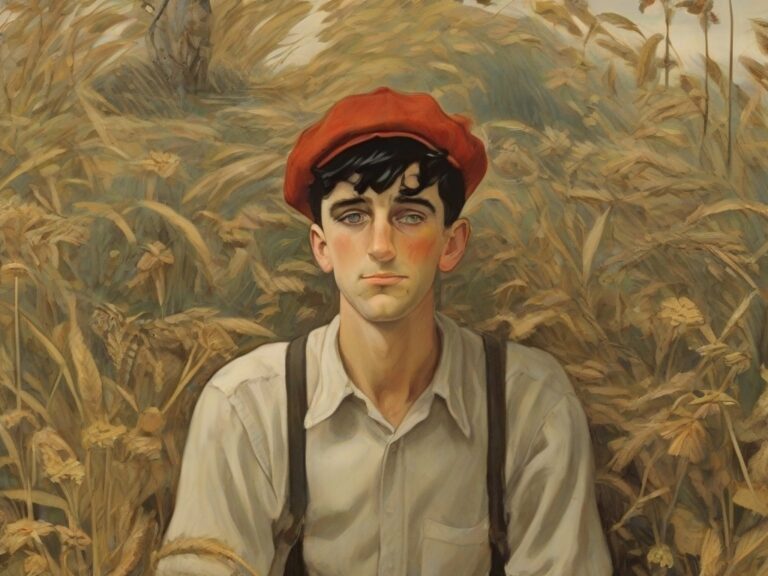In the world of literature, few novels have managed to etch themselves into the collective consciousness as deeply as J.D. Salinger’s timeless masterpiece, “The Catcher in the Rye”. Exploring the bewildering journey of its protagonist, Holden Caulfield, this iconic coming-of-age novel has captivated generations of readers since its publication in 1951. But why has this book managed to maintain such a powerful grip on our imaginations? How has it resonated with countless individuals across time?
In this article, we delve into the historical significance of “The Catcher in the Rye”, its enigmatic author, J.D. Salinger, and unravel the timeless themes that continue to strike a chord with readers today. So, fasten your seatbelts, as we take you on an alluring journey through the pages of this literary gem, revealing hidden anecdotes, insightful analysis, and a deeper understanding of the enigma that is “The Catcher in the Rye”.
The Catcher in the Rye by J.D. Salinger: Full Book Summary
General Summary for The Catcher in the Rye
Summary about the catcher in the rye.Once upon a time, there was a curious young boy named Holden Caulfield. He lived in New York City and attended Pencey Preparatory, a fancy boarding school. Holden was not like the other boys at his school; he felt disconnected from everyone around him. Holden was a dreamer, an observer, and a deep thinker. He often found himself questioning the world and searching for meaning in life.
As our story begins, it’s wintertime at Pencey Prep, and Holden has just received news that he has been expelled. Feeling lost and unsure of what to do next, he decides to leave the school immediately. Holden embarks on an eventful journey through New York City, where he experiences the ups and downs of being a teenager in the 1950s.
Holden’s first stop is in the bustling heart of Times Square, where he feels overwhelmed by the sheer number of people surrounding him. He goes to a seedy hotel where he encounters all sorts of fascinating characters. Holden finds himself yearning for genuine connection and despising the superficiality of the world he lives in.
Throughout his adventure, Holden takes us on a whirlwind tour of New York City’s hidden corners, from the frozen ponds of Central Park to the vibrant streets of Greenwich Village. Along the way, he encounters a variety of individuals, giving us a glimpse into their lives and struggles. From taxi drivers to nuns, from bartenders to cafe-goers, everyone leaves an impression on Holden in one way or another.
As Holden continues his journey, we begin to understand that he is trying to hold onto his innocence and protect others from the harsh realities of adulthood. He becomes increasingly disillusioned with the world around him, often remarking on the phoniness and hypocrisy he sees in people. Holden recalls his younger brother, Allie, who passed away a few years ago, and his little sister, Phoebe, who he deeply cares for. Holden adores his sister and sees her as one of the few people in the world who still possesses innocence and authenticity.
Holden’s encounters and musings provide insight into the thoughts and feelings of teenagers grappling with the transition to adulthood. He questions the purpose of education, the significance of wealth, and the complexities of human relationships. Through Holden’s eyes, we learn about the challenges of growing up and the difficulties of maintaining one’s identity in a world that often feels insincere.
As the story unfolds, Holden finds solace in his encounters with Phoebe, who brings a spark of hope and understanding back into his life. They share heartfelt conversations and moments that remind Holden of the importance of family and sisterly love. Phoebe’s innocence and genuine nature make her the ideal companion for Holden during his turbulent journey.
In the end, Holden realizes that he cannot protect others from the inevitable pains of growing up. He acknowledges that everyone must face the harsh realities of life, even if it means losing some innocence along the way. Holden understands that in order to find his place in the world, he must accept the imperfections of humanity and learn to let go of the things he cannot change.
“The Catcher in the Rye,” written by J.D. Salinger, is a coming-of-age novel that captivates its young readers with its thought-provoking themes and relatable characters. The story of Holden Caulfield takes us on a roller coaster of emotions, where we experience the highs and lows of teenage life. Through Holden’s journey, we learn about the complexities of the human experience, the search for authenticity, and the importance of connecting with others. It is a timeless tale that continues to resonate with readers of all ages, reminding us to cherish our innocence while embracing the inevitable challenges that life throws our way. Here you have, the Summary of the book the catcher in the rye in short stories kids.
The Catcher in the Rye Chapter Summary
Chapter 1
Holden Caulfield, the narrator, introduces himself and begins to tell the story of his experiences at Pencey Prep, a boarding school in Pennsylvania.
Chapter 2
Holden attends a history class taught by Mr. Spencer, who lectures him about his poor academic performance and lack of motivation.
Chapter 3
Holden leaves Pencey Prep and travels to New York City, where he checks into a hotel and begins to reflect on his life.
Chapter 4
Holden meets up with his friend, Ackley, and then goes to a movie with his roommate, Stradlater.
Chapter 5
Holden goes to a nightclub and then meets two women, Lillian Simmons and her friend, who he dislikes.
Chapter 6
Holden has a fight with Stradlater and then leaves Pencey Prep for good.
Chapter 7
Holden spends the night at the home of his former English teacher, Mr. Antolini.
Chapter 8
Holden wanders around New York City and then visits his little sister, Phoebe.
Chapter 9
Holden goes on a date with Sally Hayes, an old friend, but they end up fighting.
Chapter 10
Holden visits a museum and then has a conversation with two nuns.
Chapter 11
Holden meets up with an old friend, Carl Luce, and they have an argument.
Chapter 12
Holden hires a prostitute, but then changes his mind and sends her away.
Chapter 13
Holden goes to a bar and then gets into a fight with a man named Maurice.
Chapter 14
Holden spends the night in a phone booth and then goes to the home of his former teacher, Mr. Antolini.
Chapter 15
Holden has a conversation with Mr. Antolini, who offers him advice.
Chapter 16
Holden leaves Mr. Antolini’s home and then wanders around New York City.
Chapter 17
Holden meets up with his little sister, Phoebe, and they have a conversation.
Chapter 18
Holden goes to a record store and then has a conversation with a girl named Sally Hayes.
Chapter 19
Holden goes to a park and then has a conversation with a little girl.
Chapter 20
Holden goes to his family’s apartment and then has a conversation with his little sister, Phoebe.
Chapter 21
Holden leaves his family’s apartment and then goes to Central Park.
Chapter 22
Holden has a conversation with a former classmate, Ernest Morrow’s mother.
Chapter 23
Holden goes to a bar and then has a conversation with three women.
Chapter 24
Holden has a conversation with a cab driver and then goes to his family’s apartment.
Chapter 25
Holden has a conversation with his little sister, Phoebe, and then watches her ride on a carousel.
The Catcher in the Rye: Key Themes
“The Catcher in the Rye” by J.D. Salinger is a coming-of-age novel published in 1951, and it follows the story of Holden Caulfield, a disillusioned teenager struggling with the realities of life. The book explores various themes, but three key ones are alienation, authenticity, and innocence.
1. Alienation: Throughout the book, Holden constantly feels disconnected and alienated from the world around him. He struggles to connect with others, often finding their behavior and hypocrisy phony. His disdain for social conformity and the superficiality of the adult world leads to his isolation and loneliness. Holden’s alienation arises from his resistance to growing up, as he perceives adulthood as a corrupt and hypocritical realm that he wants to shield himself and others from.
2. Authenticity: Holden yearns for authenticity in a world he believes is filled with phoniness. He deeply values genuineness, honesty, and simplicity. He despises people who put on false facades, seeking instead to navigate life with a sense of true identity and purpose. This theme is exemplified by Holden’s desire for genuine connections, such as his admiration for his deceased brother Allie and his fondness for his younger sister Phoebe. However, he often struggles to maintain his own authenticity and is therefore trapped in a constant battle between his desire to be genuine and the pressures of society.
3. Innocence: A significant theme in the novel is the loss of innocence. Holden is preoccupied with preserving the innocence of children, trying to protect them from the harsh realities and hypocrisy of adulthood. He sees children as pure and uncorrupted, representing a sense of hope and authenticity. Holden’s desire to play the role of a “catcher in the rye” — someone who catches children before they fall into the darkness of adulthood — stems from his fear of losing his own innocence and the inability to face the challenges and uncertainties of growing up.
“The Catcher in the Rye” explores these themes and presents a powerful critique of society’s shallowness and its impact on Holden’s search for identity and meaning in a world he struggles to understand. It is a timeless portrayal of teenage angst, disillusionment, and the complexities of growing up.
The Catcher in the Rye: Characters
Holden Caulfield: The protagonist and narrator of the story, Holden is a 16-year-old high school student who has recently been expelled from his boarding school. He is tall and lanky, with unruly brown hair and a constantly furrowed brow. Holden has a habit of wearing his signature red hunting hat backwards, which he believes makes him stand out from the crowd. Known for his cynicism and disdain for “phony” people, Holden is an avid people-watcher and has an uncanny ability to see through people’s facades. He often sends himself into existential spirals, questioning the meaning of life and his place in the world. Despite his often gloomy demeanor, Holden has a sardonic sense of humor that often gets him into trouble but keeps readers entertained.
Phoebe Caulfield: Holden’s younger sister, Phoebe is a precocious and imaginative 10-year-old girl. She has short, curly brown hair and bright blue eyes that seem to radiate curiosity and intelligence. Phoebe is the one person in Holden’s life whom he sees as innocent and genuine, and she is often the source of his moments of genuine happiness. She is an excellent dancer and idolizes her older brother, looking up to him even when he struggles to understand himself. Phoebe has a mischievous side and can be quite stubborn at times, but she is fiercely loyal to her family and serves as a beacon of hope for Holden throughout the story.
Allie Caulfield: Holden’s deceased younger brother, Allie, is only mentioned in the book but plays a significant role in Holden’s thoughts and reflections. Allie died of leukemia when he was 11 years old, and Holden describes him as being “terrifically intelligent” and “completely genuine.” Allie had bright red hair and was known for his exceptional intellect and creativity. He served as a moral anchor for Holden, and his death greatly affected and shaped Holden’s view of the world. Holden often turns to memories of Allie for comfort and guidance, and Allie’s baseball mitt, covered with his poetry, becomes a symbol of innocence and authenticity.
Mr. Antolini: Holden’s former English teacher and mentor, Mr. Antolini is an older gentleman with thinning gray hair and a distinguished demeanor. He is described as wearing large spectacles that give him an air of intelligence. Mr. Antolini becomes an important figure in Holden’s life, providing him with guidance and advice during a moment of crisis. He is kind and understanding, offering Holden a safe haven when he is feeling lost and hopeless. Mr. Antolini is known for his eccentric teaching methods, including his habit of quoting extensive passages of literature in everyday conversation. Despite being a nurturing figure at first, Holden becomes unnerved by a seemingly inappropriate behavior from Mr. Antolini, causing him to leave abruptly.
Stradlater: Holden’s handsome and popular roommate at Pencey Prep, Stradlater is described as being a well-built, clean-cut guy with neatly styled blonde hair. He is known for his charm and charisma, often using it to win over girls without forming genuine connections. Stradlater is depicted as the epitome of everything Holden despises; he is a “phony” who lacks depth or true sensitivity. Stradlater’s interactions with Holden, particularly his treatment of Holden’s childhood friend Jane Gallagher, serve as catalysts for Holden’s feelings of anger and disillusionment.
Sunny: A young prostitute whom Holden hires during his stay at a seedy hotel in New York City, Sunny is described as having a “cheap-looking”, almost childlike appearance. She wears heavy makeup and gaudy clothing, and her high-pitched voice and mannerisms reveal her youth and inexperience. Sunny’s interaction with Holden forces him to confront his own vulnerability and moral confusion. Despite their initially uncomfortable encounter, Sunny displays a surprising level of empathy and understanding towards Holden, leaving a lasting impact on him.
The Catcher in the Rye: Symbols
1. The Red Hunting Hat: The red hunting hat becomes a significant symbol in the novel, representing Holden’s uniqueness and individuality. It is one of the few things that he values and wears consistently throughout the story. The hat becomes a symbol of his desire to stand out from society and his yearning to be different from everyone else. It also serves as a protective shield for Holden in the overwhelming world he perceives as inauthentic and uncaring.
2. The Museum of Natural History: The Museum of Natural History symbolizes Holden’s longing for stability and permanence in a world that he sees as constantly changing and phony. Holden finds solace in the museum because everything stays the same in its exhibits. He appreciates that the museum preserves the past, providing him with a sense of security and nostalgia. The museum also represents Holden’s fear of growing up, as he wants to prevent the innocence and beauty of childhood from being lost or corrupted.
3. The Ducks in Central Park: The ducks in Central Park symbolize the theme of transition and change in the novel. Holden constantly ponders the whereabouts of the ducks whenever he visits the park. The ducks serve as a metaphor for Holden’s own personal transition and uncertainty about where he fits in the world. He wonders if the ducks migrate during winter, just like he contemplates if he will ever find a home or place where he belongs. The ducks also represent Holden’s fascination with the idea of change and his struggle to adapt to it.
The Catcher in the Rye: Culture Impact
“The Catcher in the Rye” by J.D. Salinger is a literary masterpiece that has had a profound cultural impact since its publication in 1951. This coming-of-age novel follows the story of Holden Caulfield, a troubled teenager navigating life in New York City, and continues to captivate readers worldwide with its wit, relatability, and thought-provoking themes.
Historically, “The Catcher in the Rye” became an instant bestseller and has since sold over 65 million copies worldwide. It is one of the most frequently taught books in high schools and universities globally, resonating with multiple generations over the years. It not only defined the literature of the post-World War II era but also proved to be a catalyst for social and cultural change.
The book’s impact on popular culture is undeniable. Multiple iconic characters, from John Lennon to Kurt Cobain, have identified themselves as Holden Caulfield enthusiasts, further solidifying its influence. References to the novel are frequently made in movies, TV shows, and even songs, transforming it into a cultural touchstone.
“The Catcher in the Rye’s” signature humor lies in Holden’s unique voice and his biting criticism of societal expectations. His distinctive language, often peppered with sarcasm and colloquial expressions, created a new benchmark for authentic teenage dialogues in literature. Moreover, Holden’s internal struggles with identity, alienation, and the loss of innocence became a powerful symbol for the inner conflicts experienced by teenagers and young adults.
Through Holden’s quest for authenticity, the book highlights the tensions and hypocrisies of a conformist society. Its immense success contributed to questioning traditional norms and sparked important conversations about adolescent mental health, authenticity, and the pressure to conform. It championed the voice of youth rebellion, and it encouraged readers to question the expectations imposed on them, opening spaces for self-discovery and rebellion against a stifling system.
“The Catcher in the Rye” also achieved numerous milestones. It became one of the most banned and controversial books of its time due to its explicit language and depictions of rebellion. Its frequent appearance on banned books lists only fueled its popularity, as readers were drawn to its rebellious nature. The book also played a pivotal role in establishing the genre of young adult literature, paving the way for future novels that explore the complexities of teenage identities.
In conclusion, “The Catcher in the Rye” has, without a doubt, left an indelible mark on the literary, social, and cultural landscape. It continues to be celebrated for its revolutionary style, relatable protagonist, and profound impact on subsequent generations of readers. Its enduring popularity is a testament to its ability to capture the struggles and triumphs of adolescence and inspire new explorations of self-identity and rebellion.
FAQs
1. What is the plot of “The Catcher in the Rye”?
“The Catcher in the Rye” follows the story of Holden Caulfield, a teenage boy who has been expelled from his boarding school and is navigating his way through New York City. It is a coming-of-age novel that explores themes of alienation, identity, and searching for meaning.
2. When was “The Catcher in the Rye” published?
“The Catcher in the Rye” was published in 1951 by J.D. Salinger. It quickly gained popularity and has since become one of the most famous and influential works of American literature.
3. What is the significance of the title “The Catcher in the Rye”?
The title of the book refers to Holden’s fantasy of being a “catcher in the rye,” someone who stands at the edge of a cliff and catches children before they fall off the metaphorical cliff into adulthood. It symbolizes Holden’s desire to protect innocence and preserve the purity of childhood.
4. What are some major themes explored in “The Catcher in the Rye”?
Some major themes in the novel include teenage alienation and rebellion, the phoniness and hypocrisy of society, and the struggle to find one’s identity and purpose in the world. It also delves into the loss of innocence and the transition from childhood to adulthood.
5. Why is “The Catcher in the Rye” considered a classic?
“The Catcher in the Rye” is considered a classic due to its profound impact on literature and its ability to resonate with readers across generations. It explores timeless themes of adolescence and existential angst, capturing the complexity of adolescence and the universal struggle to find oneself in a changing world.
6. What is The Catcher in the Rye about?
The Catcher in the Rye is a novel by J.D. Salinger, published in 1951. It tells the story of Holden Caulfield, a 16-year-old boy who runs away from his boarding school and wanders around New York City for three days. He is disillusioned with the adult world and its phoniness, and he struggles to find meaning and connection in his life. He also suffers from the trauma of his younger brother’s death and his own mental instability. The novel is a classic of American literature and a symbol of teenage rebellion and alienation.
7. What is the main message of The Catcher in the Rye?
The main message of The Catcher in the Rye is that growing up is inevitable and painful, and that one must find a way to cope with the loss of innocence and the complexity of the adult world. The novel shows how Holden, who is afraid of change and maturity, tries to escape from his problems by running away and rejecting society. However, he also realizes that he cannot avoid reality forever, and that he needs to find some meaning and connection in his life.
8. What is the significance of the novel’s opening line?
The novel’s opening line introduces the narrator, Holden Caulfield, and his cynical and rebellious voice. It also sets the tone for the rest of the story, which is a flashback of Holden’s experiences in the past few days. The opening line also hints at Holden’s unreliability as a storyteller, as he says that he does not feel like telling the reader “all that David Copperfield kind of crap,” implying that he will omit or distort some details of his life.
9. Why does Holden hate “phonies”?
Holden hates “phonies” because he thinks they are dishonest, superficial, and hypocritical. He sees phoniness everywhere, in his school, his family, and his society. He thinks that phonies pretend to be something they are not, and that they do not care about anything genuine or meaningful. Holden also hates phonies because he feels alienated and misunderstood by them. He thinks that they do not share his values or his vision of the world.
10. What is Holden’s relationship with Phoebe like?
Holden’s relationship with Phoebe is one of the few positive and genuine ones he has in the novel. Phoebe is Holden’s younger sister, who is smart, creative, and compassionate. Holden loves and admires Phoebe, and he considers her one of the few people who understand him. He also feels protective of her, and he wants to preserve her innocence and happiness. Phoebe is also one of the few people who can challenge Holden and make him face his problems. She criticizes him for being negative and aimless, and she encourages him to find something that he likes and wants to do in life.
11. What does the title The Catcher in the Rye really mean?
The title The Catcher in the Rye comes from Holden’s misinterpretation of a song that he hears a young boy singing: “If a body catch a body coming through the rye.” Holden imagines himself as a catcher in the rye, a person who stands in a field of rye and catches the children who are playing there before they fall off a cliff. This image represents Holden’s fantasy of saving the innocence of childhood from the corruption of adulthood. However, the actual lyrics of the song are “If a body meet a body coming through the rye,” which suggest a more sexual and mature meaning. This shows that Holden’s fantasy is based on a misunderstanding, and that he cannot escape the reality of growing up.










